IBDP Online Test Series By iitianacademy
Comprehensive Test Preparatory package targeted towards IBDP
Question
The diagram shows a simplified fermenter used in the production of penicillin.
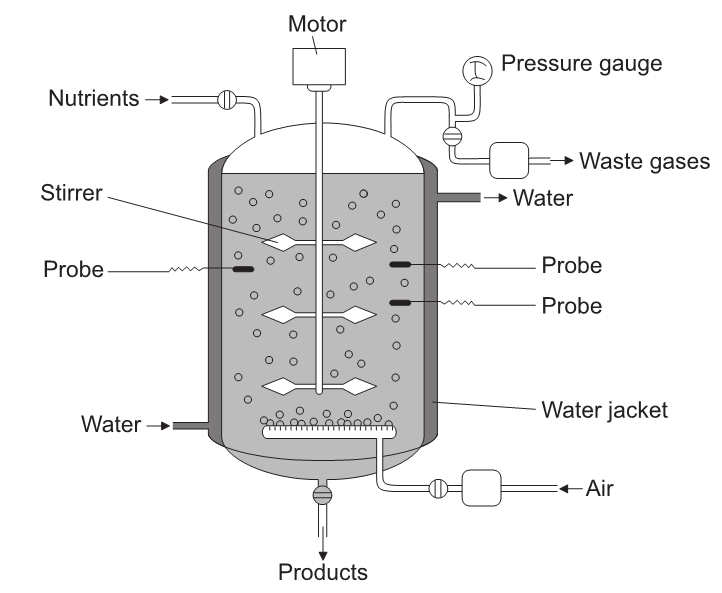
[Source: Valero, F, del Rio, JL, Poch, M and Sola, C (John Wiley and Sons, 1992). Studies on Lipase Production by Candida rugosa Using On-line Enzymatic Analysis. Annals of the New York Academy of Sciences, 665, pp. 334–344.
doi: 10.1111/j.1749-6632.1992.tb42596.x]
State two conditions in the fermenter that would be monitored by the probes.
Suggest a reason that the fermenter is surrounded by a water jacket.
Identify the waste gas produced.
Explain the process of penicillin production in the fermenter.
Answer/Explanation
Markscheme
a. pH
b. temperature
c. oxygen levels
d. viscosity
e. foam
f. carbon dioxide
Accept any two conditions for the mark
[Max 1 Mark]
a. maintain constant temperature/insulation
b. cooling
[Max 1 Mark]
carbon dioxide/CO2
a. inside of fermenter is sterilized «to prevent growth of other organisms»
b. «penicillin» fungus/Penicillium added to fermenter
c. nutrients are provided to allow the fungus to grow
d. when nutrients are used up, penicillin is produced
e. penicillin extracted from mixture in fermenter
f. penicillin purified ready for medical use
Accept named nutrient eg: glucose
[Max 3 Marks]
Question
The graph shows the development of biogas production and substrate utilization at Svensk Biogas (Sweden) from 1997 to 2009.
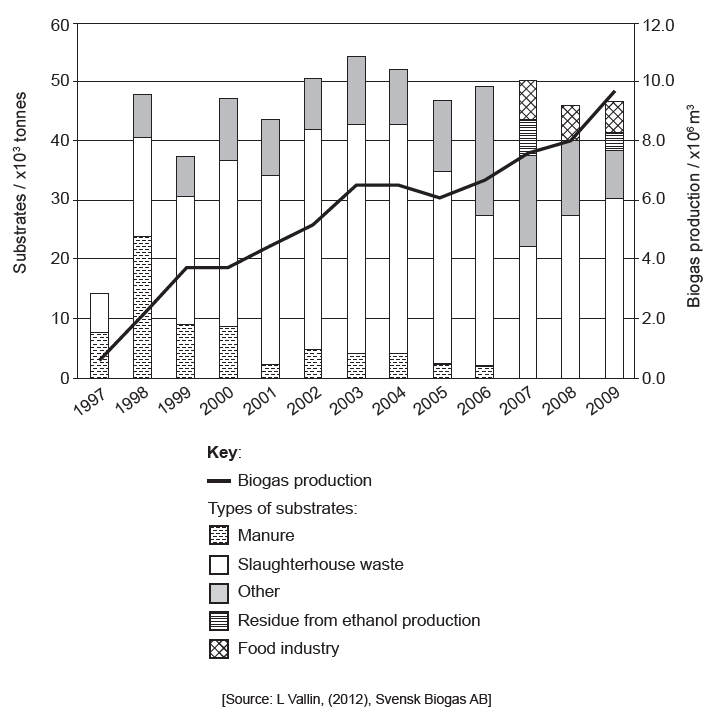
Biogas production in a fermenter requires a substrate. State another requirement for this process.
Suggest reasons based on the data in the graph for increases in biogas production at Svensk Biogas.
Outline the principles of fermentation by continuous culture.
Answer/Explanation
Markscheme
lack of oxygen/anoxic/anaerobic conditions / acidic pH / warm temperature / methanogens / acidogenic bacteria
a. increased variety of substrates used
b. change in the proportion of substrates used
OR
from 1997 to 2004 increase in slaughterhouse waste
c. less reliance on manure/increase use from food industry
d. waste from food industry results in higher biogas yield
a. microbial population can be maintained in a state of exponential growth for a long time
OR
concentration of microorganisms in fermenter stable
b. «balanced growth is» maintained by keeping nutrients/medium/pH/ temperature/ oxygen level constant
c. nutrients are added AND products removed «at steady rate»
d. probes used to monitor conditions within fermenters
e. open fermentation/fermenter
Question
Freshwater invertebrates were sampled by students at three sites along a river in central France. The animals were identified and counted. The diversity of each site can be compared using Simpson’s reciprocal index.
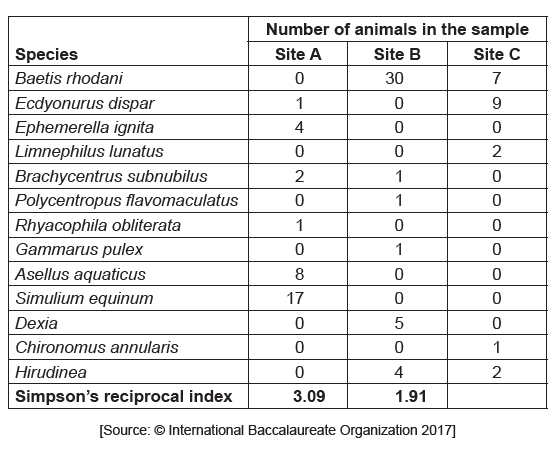
Simpson’s reciprocal index is given by the following formula:

Calculate the diversity of site C. Working should be shown.
Site A has a higher Simpson’s reciprocal index than Site B showing that its diversity is higher.
Explain the reason that ecologists consider Site A to have a higher diversity than Site B, despite both sites having six different species present.
Discuss the advantages and disadvantages of in situ conservation methods.
Answer/Explanation
Markscheme
a. ![]()
b. = 3.56 «allow 3.55»
a. the species in Site A are more evenly represented than site B
b. site B has a large number of one species «but very few in the other 5»
c. Simpson’s reciprocal index is a measure of species evenness as well as species richness
Advantages:
a. conservation in the natural habitat / ecosystem
b. the species will have all the resources that it is adapted to
c. the species will continue to evolve in their environment / can maintain genetic diversity
d. the species have more space so a bigger breeding populations can be kept
e. it is cheaper to keep an organism in its natural habitat
f. established food webs/ species interactions can be maintained
Disadvantages:
g. it is difficult to control illegal exploitation «eg poaching»/harder to monitor populations
h. the area may need restoring / may be required for other purposes
i. alien species are difficult to control
j. species close to extinction are harder to conserve
k. management/protection may represent a significant cost
Question
Sugar solution in a fermenter was inoculated with a culture of fungus, incubated at 30°C and left for 10 days to produce citric acid. The mass of sugar consumed and the mass of citric acid produced was measured daily.
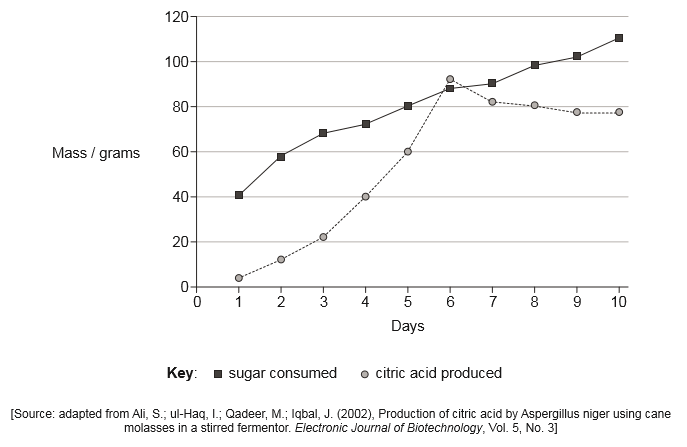
State a suitable fungus for the production of citric acid in the fermenter.
Suggest a reason that fermentation is most successful at 30°C.
Suggest reasons for the changes in mass of sugar and citric acid after day 6.
State two uses of the citric acid produced.

Answer/Explanation
Markscheme
Aspergillus/A niger/Aspergillus niger
enzymes work optimally/well/efficiently at this temperature
“Enzyme” is essential for the mark.
a. sugar consumption continues to increase because it is used in respiration / produces energy
b. products inhibit the reaction so no increase in citric acid
OR
negative feedback inhibits the reaction so no increase in citric acid
OR
decrease in pH may inhibit the enzymes
a. add a sour/acidic flavour to food/drink / change flavor / enhance taste
b. can act as a preservative in food/drink/cosmetics
c. controls pH in food/drink/cosmetics
Do not accept “food additive”.
Question
The photograph shows apparatus used to culture microorganisms in order to produce a metabolite.
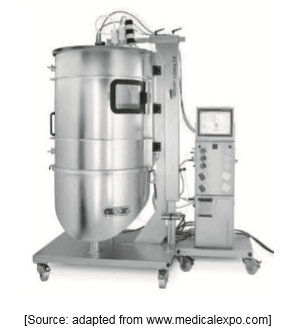
State the general term for the reaction, involving microorganisms, that takes place in the apparatus shown.
Other than temperature and pH, state one variable that should be monitored during continuous culture in the apparatus shown.
State the binomial name of an organism used in continuous culturing to produce citric acid used as a preservative.
Answer/Explanation
Markscheme
Fermentation
O2 «uptake»
CO2 «production»
Cell density
Pressure
Speed of stirrer
Quantity of nutrients/substrate/named nutrient
Aspergillus niger
Complete genus and species name is required.
Question
The yeast Brettanomyces bruxellensis is a contaminant of wine which when present produces acetic acid, the main component of vinegar. The presence of acetic acid can lead to economic losses as it alters the taste of the wine and inhibits the growth of Saccharomyces cerevisiae, thus decreasing the ethanol production. Scientists investigated the effect of changing the temperature in fermentation tanks containing only Brettanomyces bruxellensis and a growth medium containing glucose in order to understand the dynamics of this contaminant.
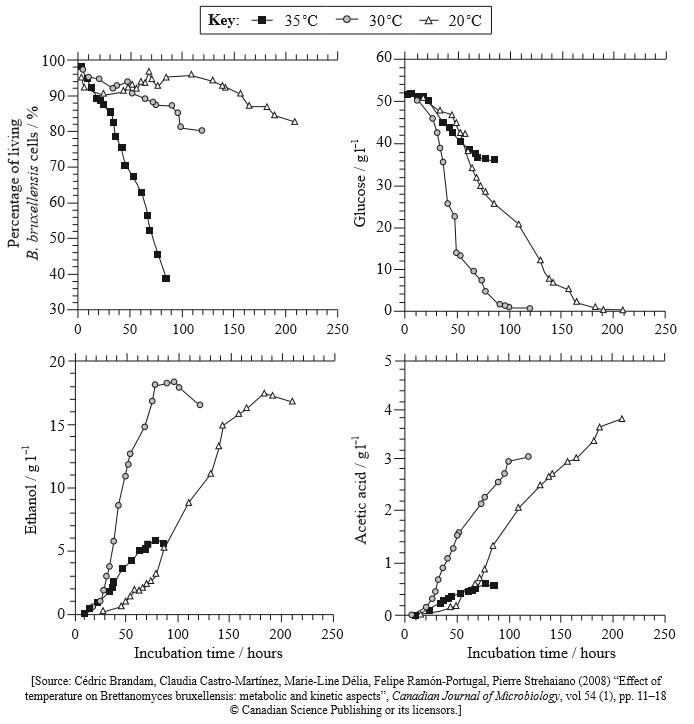
State the concentration of glucose at 20°C after 110 hours of incubation, giving the units.
State the effect of increasing temperature from 20°C to 30 °C on the rate of production of ethanol.
Deduce one reason why there were no more rises in ethanol concentration after 120 hours at 30°.
Deduce one reason why the concentration of ethanol and acetic acid at 35°C does not rise after 80 hours despite the fact that the concentration of glucose is still high.
Discuss the idea of producing wine using a lower temperature range to avoid economic losses due to contamination by yeasts other than S. cerevisiae.
Answer/Explanation
Markscheme
20 g l–1 (Accept answers from 20 to 21. Units required.)
at 30 °C ethanol produced more quickly/increased rate of production/positive correlation
glucose ran out
cells are dying / enzymes denatured
Arguments against low temperature
a. high temperatures kill B. bruxellensis;
b. high temperatures results in low acetic acid in wine;
c. high temperature results in low alcohol content;
Arguments for low temperature
d. rate of fermentation/use of glucose/alcohol production is higher;
e. no real arguments for low temperature as B. bruxellensis growth rate/acetic acid production high;
Must include at least one for and against point for full marks.
Question
In 2003, the Integrated Approach to Community Development (IACD) organization introduced the chulli water purifier to homes in Bangladesh that had not previously had access to safe drinking water. It was designed to be made cheaply from local materials. The purifier uses sand filtration to remove organic particles and heat treatment to eliminate microbes from water.
Water samples from 15 different locations containing high levels of the bacterium E. coli were passed through the purifier at different flow rates and temperatures to test its effect on contaminated water. The shaded area of the graph below represents the recommended temperature and flow rate for using the purifier.
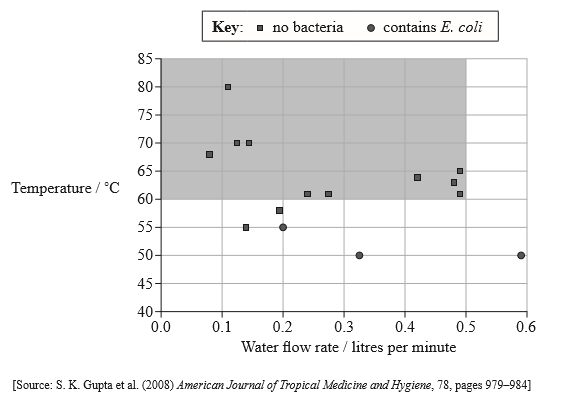
Evaluate the chulli purifier as a method of controlling microbial growth.
Answer/Explanation
Markscheme
a. water purifier is effective in removing bacteria;
b. no bacteria in 12/15 test sites, regardless of temperature or flow rate;
c. flow rate is less important than temperature;
d. no information about how contaminated the water was before various treatments;
e. no information about how effective the water purifier is in removing other harmful bacteria/substances;
Question
Explain how Gram staining is used in microbiology.
Discuss the possible consequences of gene therapy.
Answer/Explanation
Markscheme
a. Gram staining is used to classify bacteria/Eubacteria;
b. cell wall structure determines how Gram stain is received;
c. bacteria termed as Gram-positive or Gram-negative;
d. Gram-positive bacteria appear purple;
e. Gram-negative bacteria (stain less intensely and) appear pink/red;
most attempts have been unsuccessful/caused harm or death/caused emotional trauma/conflicts of interest/ethical issues;
might alleviate (genetic) condition / correct a (genetic) defect;
Question
The bacterium Vibrio fischeri produces an enzyme called luciferase. This bacterium often colonizes the squid (Euprymna scolopes). A mutant strain of V. fischeri was obtained that was unable to produce luciferase. The graph shows the mean luminescence per squid after being colonized by the parental and mutant bacterial strains.
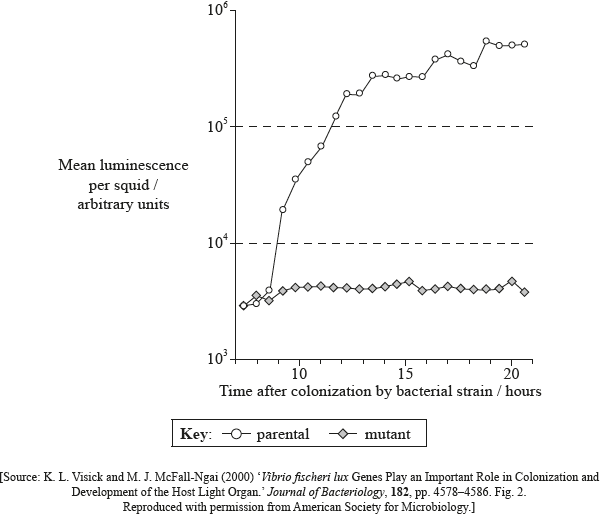
State the mean luminescence per squid 11.5 hours after colonization by parental V. fischeri.
Between 8.5 and 10.5 hours after colonization with the parental bacterial strain, luminescence increases by a factor of approximately 10. Estimate the factor by which luminescence increases between 8.5 and 17 hours after colonization with the parental bacterial strain.
Using the data in the graph, distinguish between luminescence in squid colonized by the parental and mutant bacterial strains.
Bioluminescence only happens when V. fischeri becomes part of a population with high density, for example when bacteria colonize the light organs of squid. Evaluate whether the data supports this hypothesis.
Answer/Explanation
Markscheme
“>105
(per squid)
100
low luminance in mutant strain while high luminance in parental strain (after 8 hours);
increase between 8 and 15 hours in parental strain but no increase in mutant strain;
only when more bacteria have grown (7 hours after colonization) luminescence can be seen;
luminescence has a rapid increase which could be caused by exponential growth of bacteria / population growth curve / example of quorum sensing;
there is no data for the number of bacteria colonizing the squid;
Question
Fungi of the genus Botryosphaeria have been found to produce certain oxidizing enzymes, laccases, that are effective in treating contaminated water and soils. Studies were undertaken to test the effects of veratryl alcohol concentrations and fermentation time in order to optimize the industrial production of laccases. Statistical analysis of the data was used to develop the graph below.
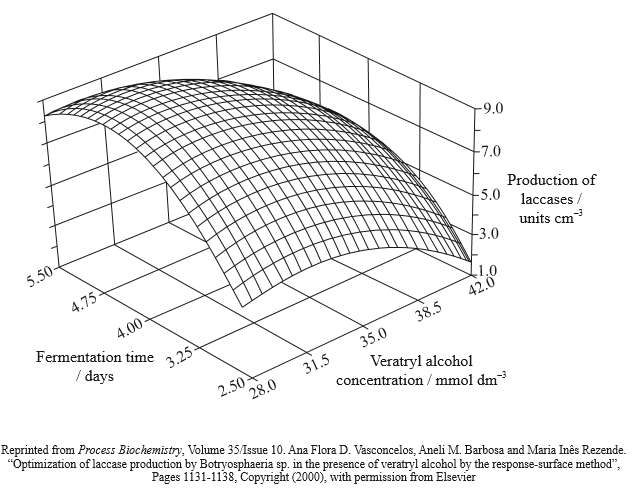
Identify the amount of laccases produced when the veratryl alcohol concentration is at its highest level and the fermentation time is at its shortest.
Identify the amount of laccases produced when the veratryl alcohol concentration is at its lowest level and the fermentation time is at its longest.
Analyse the overall effects of the veratryl alcohol concentration and fermentation time on the production of laccases.
Deduce from the graph the optimal conditions for maximizing the biotechnological production of laccases.
Answer/Explanation
Markscheme
1.6 (units) cm–3 (accept answers in the range of 1.5 units cm–3 and 1.7 units cm–3)
8.3 (units) cm–3 (accept answers in the range of 8.2 units cm–3 and 8.4 units cm–3)
as fermentation time increases laccase production rises then falls; (accept converse)
as veratryl alcohol concentration increases laccase production rises then falls; (accept converse)
optimum fermentation time is 4.75/5.0/5.25 days; (accept converse)
most laccase overall with low veratryl alcohol concentration and long fermentation; (accept converse)
optimum veratryl alcohol concentration is 33/34/35 mmol dm–3;
fermentation time has greater effect than veratryl alcohol concentration;
the best time for fermentation appears to be 4.75 days; (allow 4.75 to 5.25 days)
with a veratryl alcohol concentration of 33 mmol dm–3 / moderate veratryl alcohol concentration; (allow 33 to 35 mmol dm–3)
Question
Distinguish between Archaea and Eukarya.
Label the parts of the cell walls in Gram-positive Eubacteria and Gram-negative Eubacteria shown below.
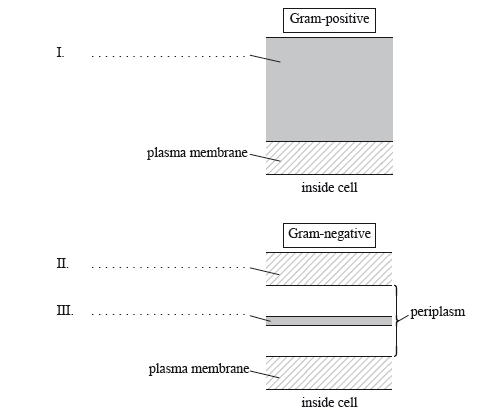
Answer/Explanation
Markscheme
a. membrane-bound organelles present in Eukarya but absent in Archaea;
b. 70S ribosomes in Archaea whereas 80S ribosomes in (cytoplasm of) Eukarya;
c. nuclear envelope in Eukarya, not in Archaea;
d. introns are present in Eukarya but only in some genes of Archaea;
e. histone proteins present in all Eukarya but only in a few Archaea;
f. the membrane lipid structure is unbranched in Eukarya but branched in Archaea;
g. Archaea can inhabit extreme habitats while Eukarya cannot;
I. peptidoglycan;
II. outer membrane/layer of lipopolysaccharide and protein;
III. peptidoglycan;
Question
State two fuels that can be produced from biomass using microbes.
Answer/Explanation
Markscheme
ethanol;
methane;
